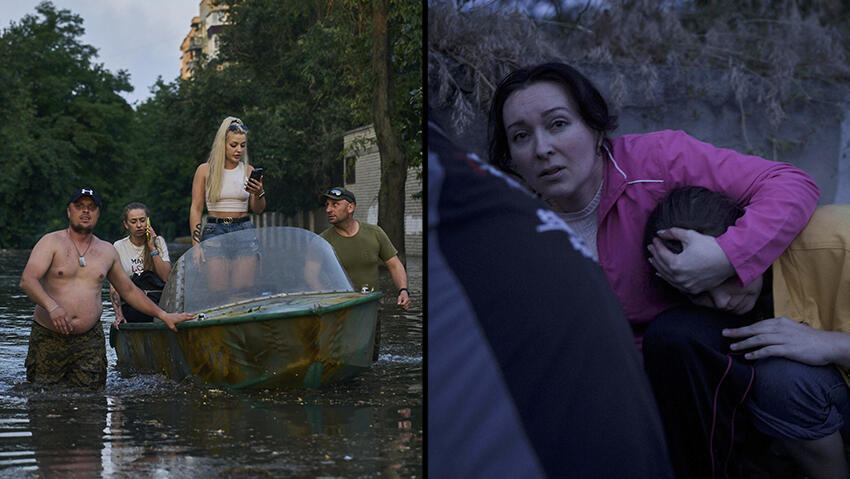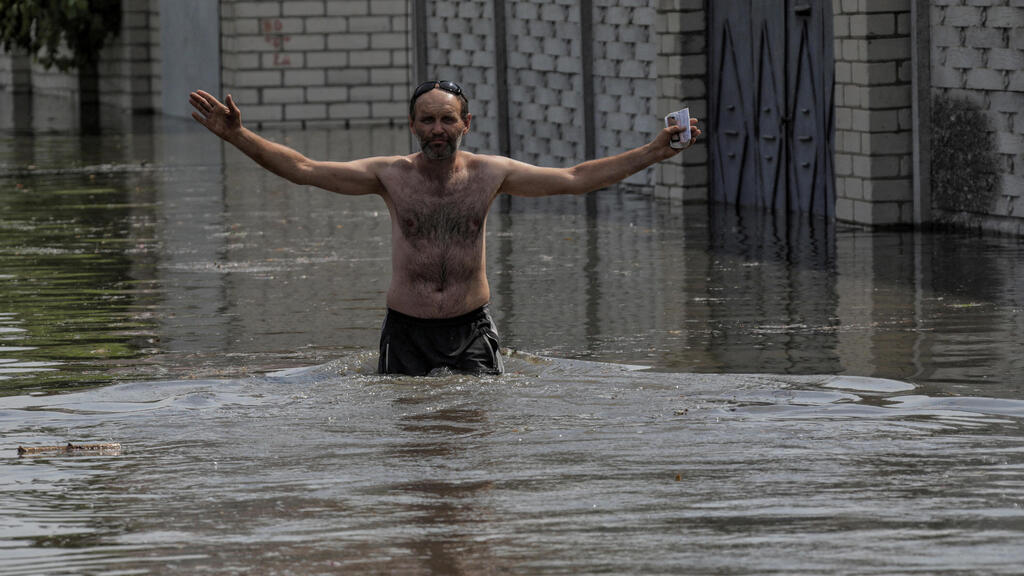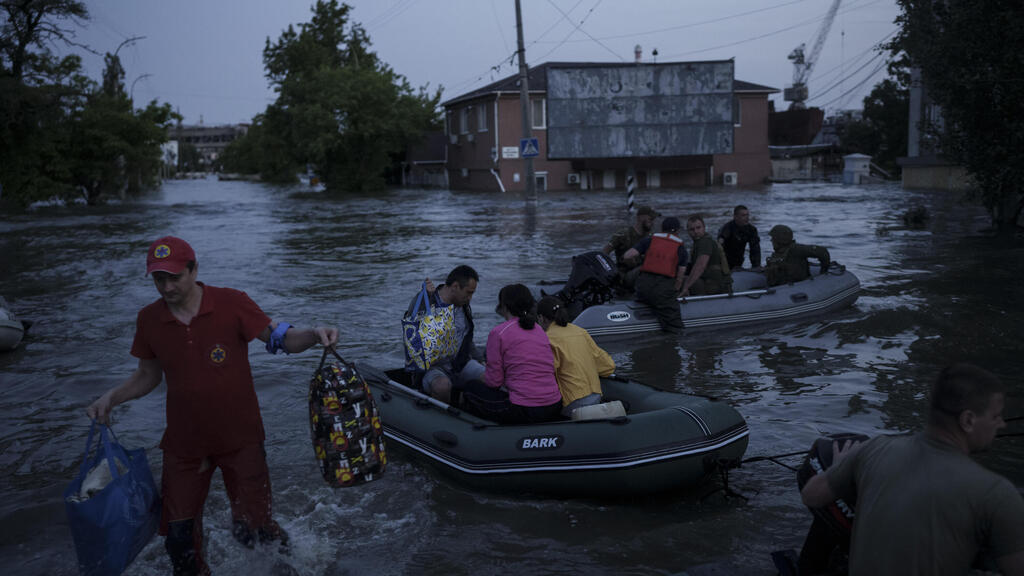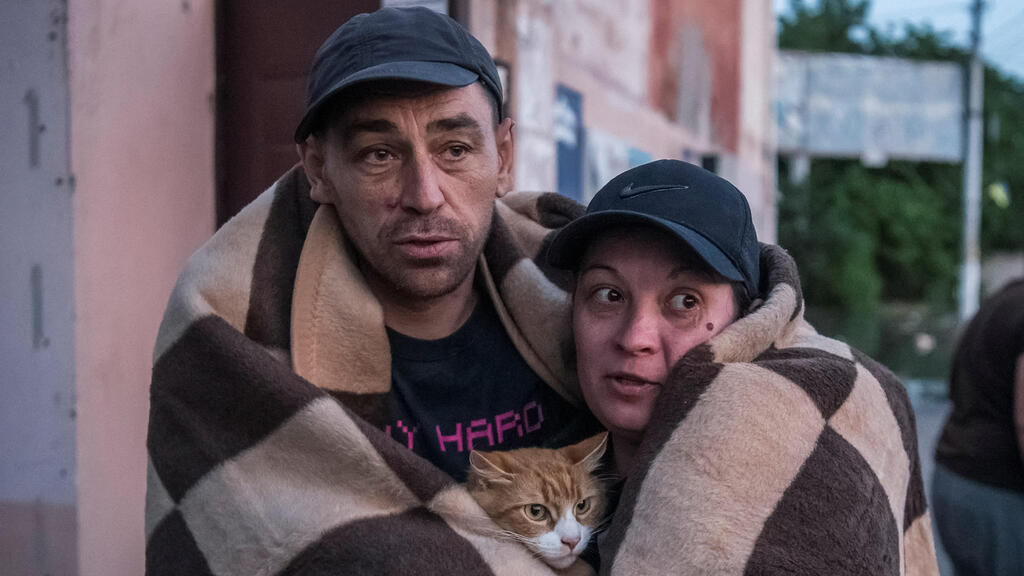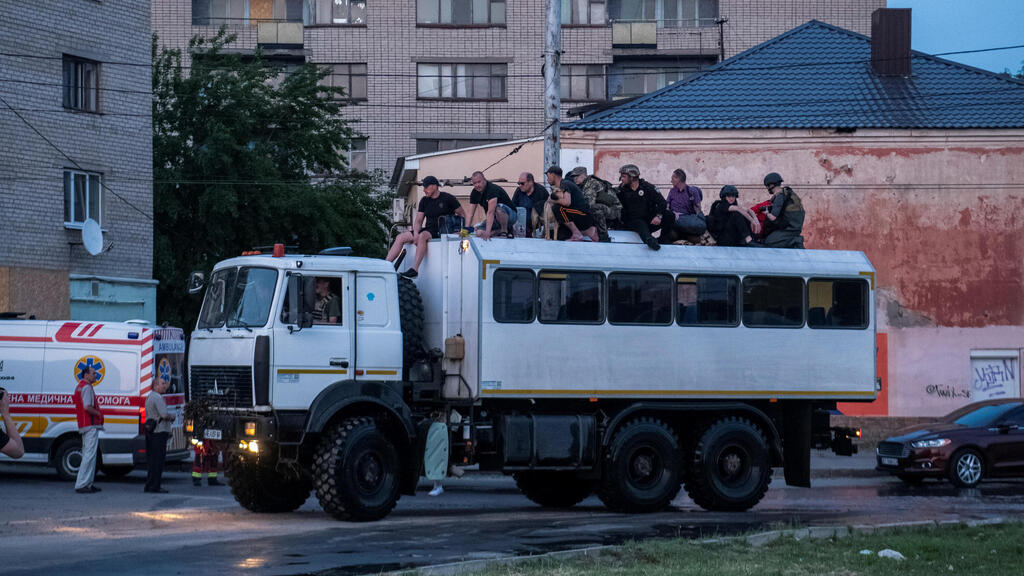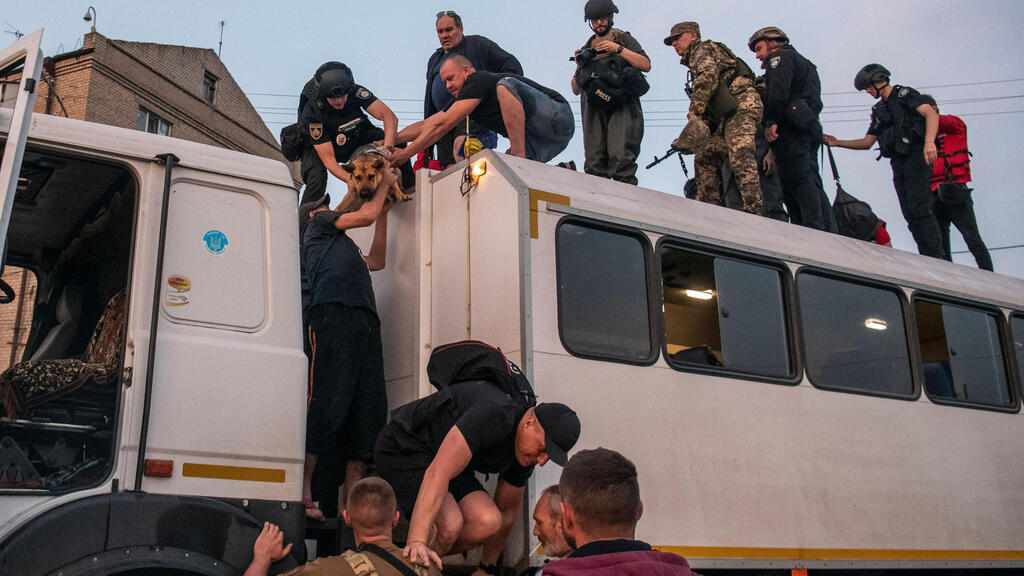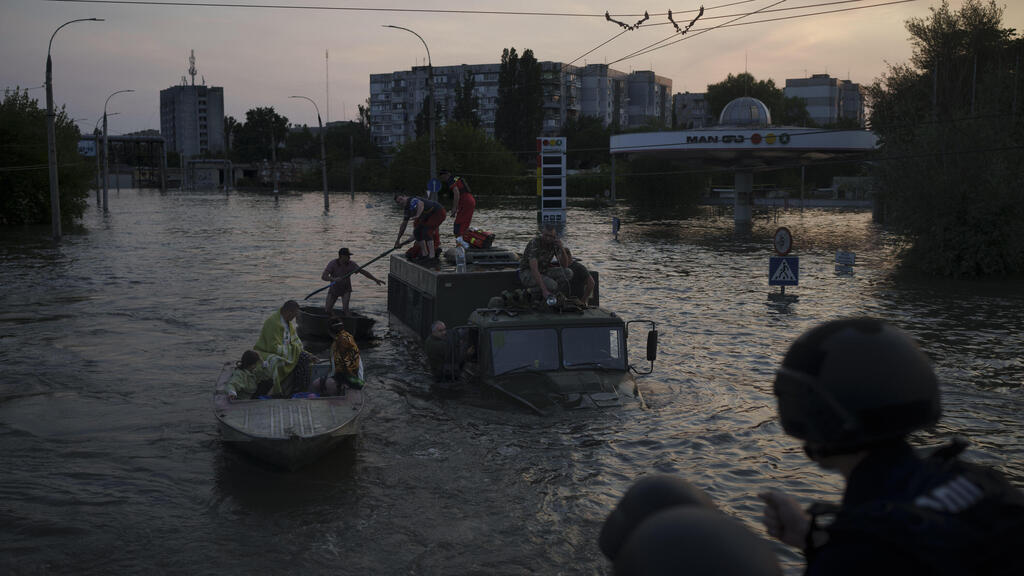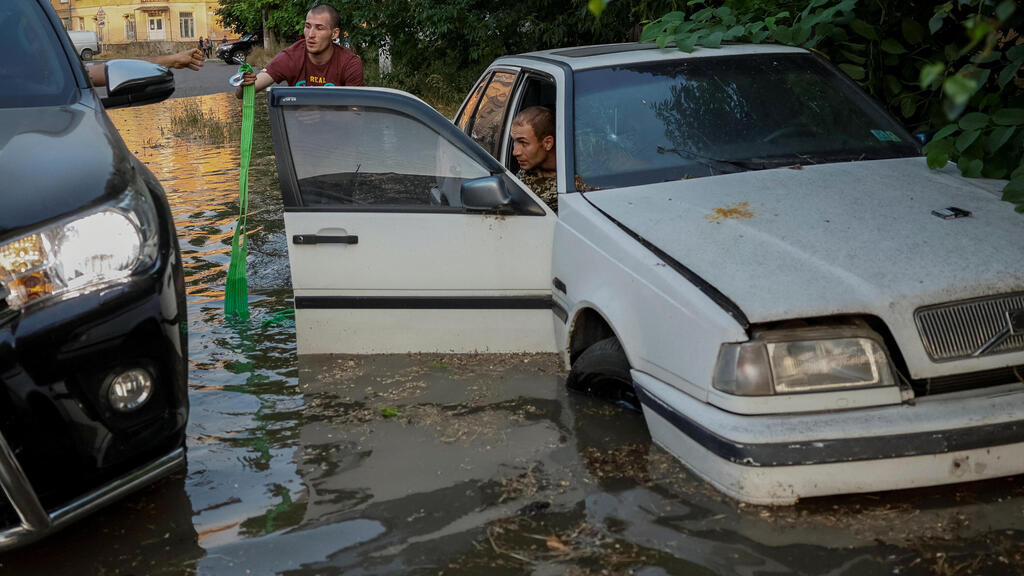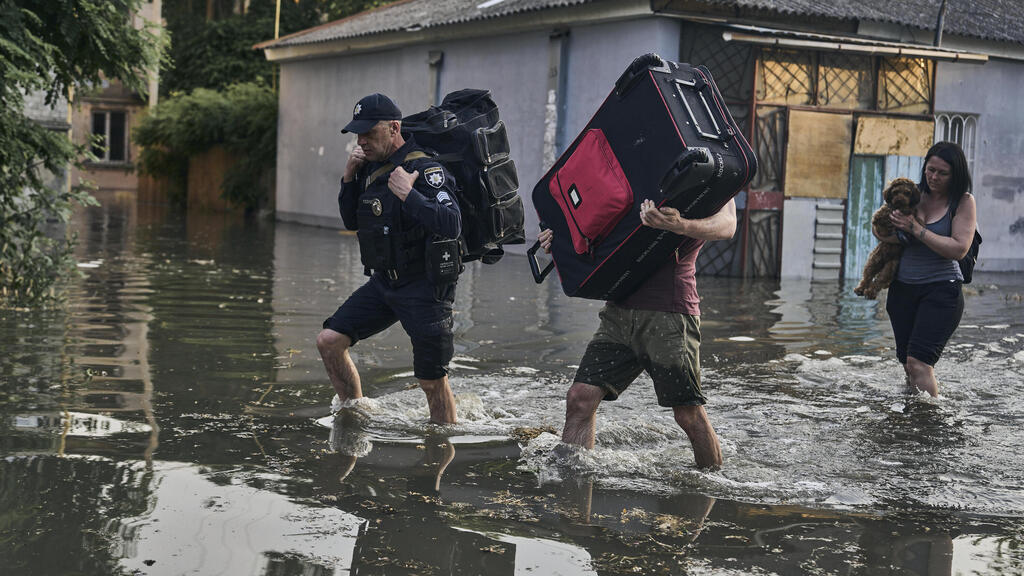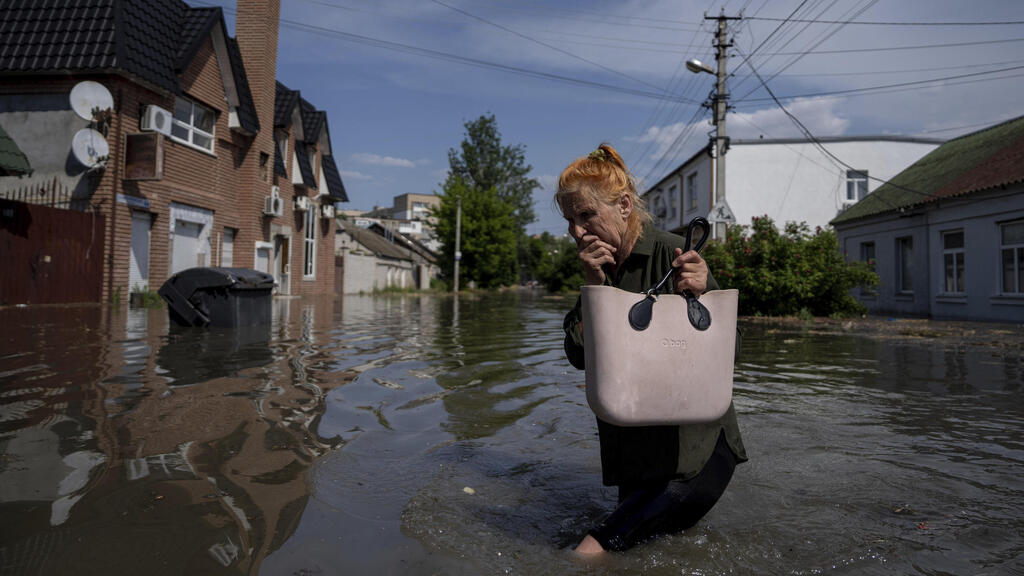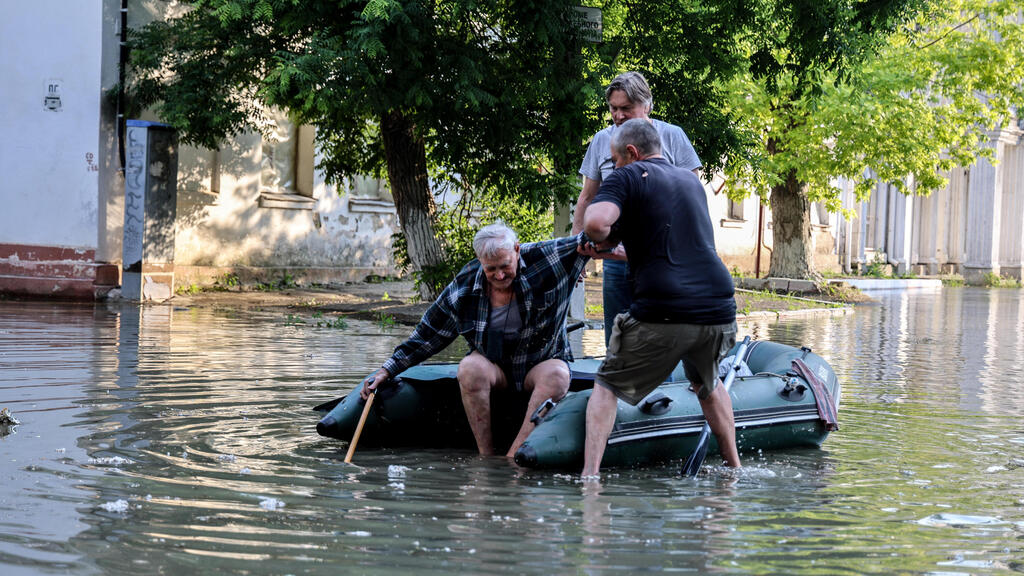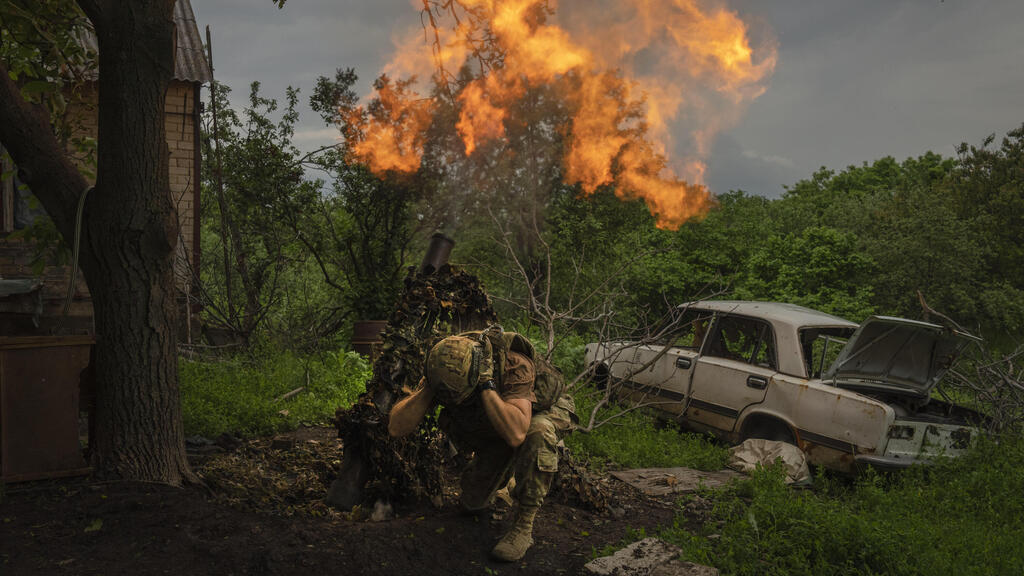Floods due to the Kakhova dam explosion
(Reuters)
The extensive evacuation operation of thousands of residents in the Kherson region in southern Ukraine continues on Wednesday, a day after dozens of settlements and large agricultural areas were flooded due to the breach of the Kakhovka dam. The dam collapsed on Tuesday morning after a massive explosion that Ukraine and Western sources suspect Russia to be behind, likely with the intention of disrupting the Ukrainian counteroffensive.
More Stories:
Wednesday morning, reports from Ukraine stated that during the night an additional 1,457 people were evacuated from their homes in areas under Ukrainian control on the northwestern side of the Dnipro River, after it was reported Tuesday that the authorities were working to evacuate 17,000 people from the area. The Russians, who control the southeastern side of the river, reported Wednesday morning that approximately 1,300 people were evacuated from these occupied areas, and that 2,700 houses were flooded.
The Dnipro River serves as the border between the warring sides in this part of southern Ukraine, after Russian forces withdrew from the provincial capital of Kherson last November to the other side of the river.
So far, there have been no reports of casualties, but estimates suggest that only after the waters recede, possibly in a few days, can the scope of the disaster be determined, and there is concern that it may turn out to be quite severe. Authorities in Ukraine estimate that a total of 42,000 people are at risk of flooding on both sides of the river, in approximately 80 different settlements and villages.
Images published on Tuesday night by the Maxar aerial photography company testify to the fact that the immense flood has inundated an area of about 2,500 square kilometers. The satellite pictures from space show entire neighborhoods and villages that have been flooded, with the water reaching up to the rooftops in some areas.
15 View gallery
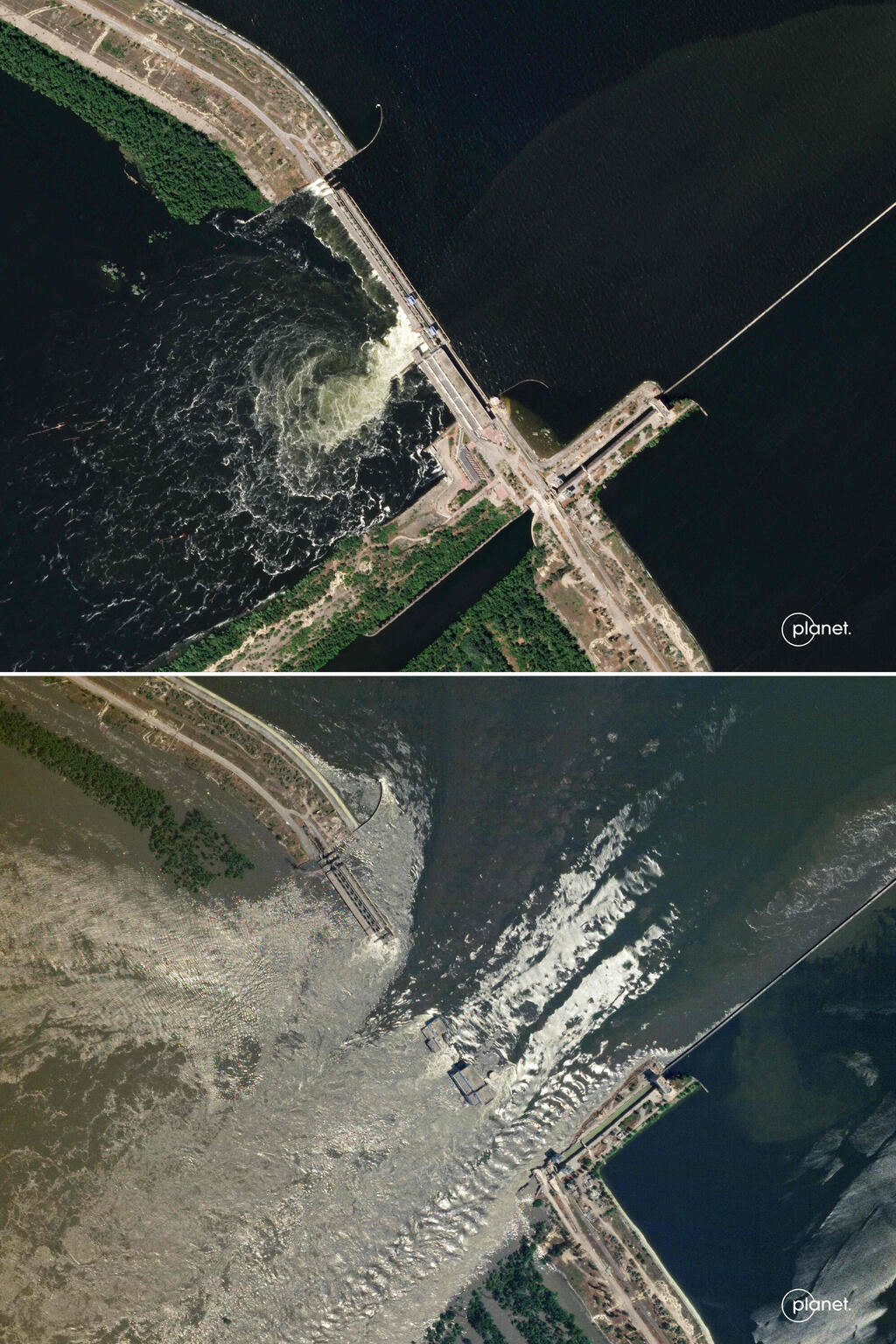

Kakhova dam explosion as seen from the air
(Photo: AFP PHOTO / Satellite image ©2023 Maxar Technologies)
It is unclear how long the flooding will continue, and although Wednesday morning there were reports from the town of Nova Kakhovka, located near the breached dam, that the water level began to drop, the pro-Russian authorities in the area reported that in other places the expectation is that the water level will continue to rise for three to 10 days. Conversely, a senior Ukrainian official stated at noon that the hope is that the water level will stop rising by the end of the day.
Evacuees forced to leave everything behind, local dogs left standed
In Nova Kakhovka, it was reported at noon that 100 residents were trapped due to the flooding, and efforts are being made to rescue them. Seven individuals are reported missing. One of the Ukrainian residents there stated that he prefers to stay in the flooded area and not obey the evacuation orders, fearing that Russian soldiers might shoot at him: "They say they are ready to open fire without warning," he said.
15 View gallery
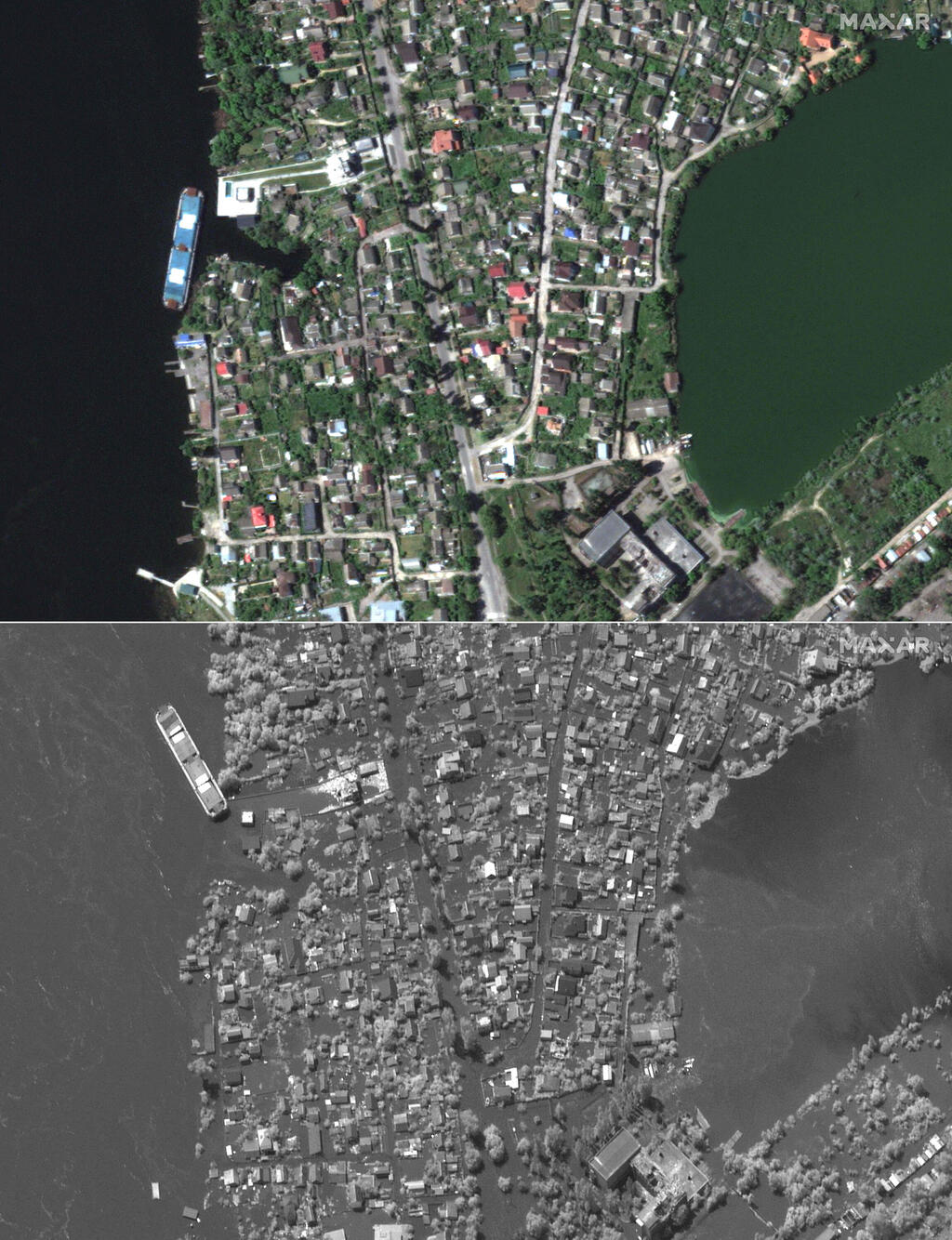

After the Kakhova dam explosion as seen from the air
(Photo: AFP PHOTO / Satellite image ©2023 Maxar Technologies)
The authorities in Nova Kakhovka reported Wednesday morning that the local cemetery was also flooded. Furthermore, the local zoo was completely flooded, and its staff reported that all 300 animals in it perished. The Ukrainian Ministry of Defense published on its Twitter account some pictures of the animals, including a small monkey holding flowers in its hands, with the message: "This is ecocide (environmental massacre). The Russians want to destroy everything that is alive."
In the territories under Ukraine's control, on the northwestern bank of the river, the evacuation operation continued during the night under the bombardment of Russian forces. Wednesday morning, the Ukrainian governor of Kherson, Oleksandr Prokudin, reported that one person was killed and another injured in these bombings.
The Russians, it is noted, are shelling the area under Ukrainian control in Kherson since their invasion last year, and it seems that even the current severe humanitarian disaster does not deter them from continuing the attacks. A photographer from the Associated Press news agency captured a group of residents who had to take cover from the bombings during the evacuation operation, and in the photo a mother is seen sheltering her young daughter and holding her close to her chest.
"I lost everything I have"
Meanwhile, in other areas, it was reported that the water level rose on Tuesday by 10 meters or even more. In the city itself, located about 60 km south of the breached dam, the water level rose by 3.5 meters. However, even this was enough to flood numerous roads and houses, and residents were seen wading through streets turned into rivers with water up to their knees while carrying their belongings in plastic bags.
"Everything is flooded with water, all the furniture, the fridge, the food, all the flowers, everything is flooded. I don't know what to do," said Oksana, a 53-year-old resident of the city who escaped from her home. A fleet of buses, trains and private cars was sent to Kherson from other regions in Ukraine to assist in the evacuation to other cities and shelter for those evacuating.
Wednesday morning, Rami Mesika, an Israeli resident of Kherson who was also forced to flee his flooded home in the city, was interviewed by Ynet. "I am among the first whose house was flooded. I live right by the river," he said. He sought refuge in the home of an Israeli acquaintance in Odessa and mentioned that he also heard the sounds of the bombings. "I lost everything I have – documents, furniture, clothes, everything. It's a huge disaster, and I don't know how to process it. I lost everything. A big house with a parking spot, I invested in it, I built it. Everything is gone." He expressed hope that the Ukrainian government would compensate him but added, "There is a good chance I will return to Israel."
Some residents of the area initially requested to stay in their homes, but as the water level continued to rise, they were forced to flee. Some residents found themselves trapped in the river, having to board boats or climb on the roofs of trucks floating in the water. One of them threw his dog from the roof of one truck that got stuck onto the roof of another truck, and in the background the cries of dogs left behind could be heard. "The Russians targeted the dam and didn't think about the consequences; we will never forgive them," said one of the evacuees angrily.
The "durable" dam and the blame game
Meanwhile, the question of responsibility for the explosion of the dam continues to be debated worldwide, with both sides blaming each other. The Kakhovka Dam, it should be noted, is one of the most important dams in Ukraine and one of the six dams built on the Dnipro River.
This colossal structure, made of armored concrete, is 3.2 km long and 30 meters tall. The dam was built during the Soviet era in 1956. Aside from the critical electricity generated by the hydroelectric power station operating in it – which was completely destroyed in the explosion – the dam serves as a vital water source for drinking and agriculture in the entire region. The massive reservoir created at the top of the river, the Kakhovka Reservoir, covers an area of 2,155 square kilometers, with a capacity of 18 million cubic meters of water – 4.5 times the volume of the Sea of Galilee – and Tuesday morning, it began to overflow downstream.
Russia has controlled the dam since the early stages of the invasion of Ukraine in February of last year, and it has continued to hold onto it even after its forces retreated to the other side of the river in November. In Ukraine, they claim that "Russian terrorists" operated inside the dam with explosive devices, with the intention of destroying it and thus disrupting the counter-attack they were planning: the dam could have easily been used by the Ukrainians to cross the river, and the widespread flooding of the area would greatly hinder the passage of military forces, such as tanks and other armored vehicles.
In Russia, on the other hand, the blame is directed toward the Ukrainians for the destruction of the dam, and they provide several versions: Kremlin spokesperson Dmitry Peskov claimed it was a "Ukrainian sabotage operation," and did not provide further details. Other Russian sources said that the dam was damaged by a Ukrainian missile strike, and some even suggested that it simply "collapsed on its own" due to previous damage.
Indeed, the dam suffered damage in the surrounding areas last autumn, and at that time, both sides blamed each other. However, experts and military analysts around the world dismiss the Russian explanations and tend to accept the Ukrainian accusation. The New York Times reported Wednesday morning that those experts believe that the likelihood of such a massive dam collapsing due to an external attack is quite low and that it is much more reasonable to assume that the destruction was caused by an internal explosion, one that would direct all the explosive force towards the reinforced concrete walls of the dam.
Even then, one of the experts explained to the newspaper, a high-intensity explosive charge with hundreds of kilograms of explosives would likely be required to cause a collapse like the one that occurred Tuesday around 2:50 a.m.
"A missile attack could not have caused such destruction because the facility was designed to withstand a nuclear explosion," added Ihor Syrotiuk, the head of the Ukrainian company managing the country's hydroelectric power stations, in a conversation with The Times. "It is clear – there was an internal explosion at the station."
One of Russia's arguments for claiming that Ukraine is seemingly behind the dam collapse is that the water from the Kakhovka Reservoir also serves the residents of the Crimean Peninsula, which Russia annexed in 2014. After the annexation, Ukraine cut off the water supply to the peninsula, but Russia restored it by capturing the dam last year. Authorities in Crimea reported on Tuesday that due to the breach, the water level in the canal that transfers water to the peninsula from the Kakhovka Reservoir started to drop.
However, in the West, it is difficult to accept the claim that Ukraine would harm its territory and its own people to such an extent. They point out the immediate military advantage that the widespread floods bring to the Russians, as it hampers a possible counteroffensive in the region.
"Environmental murder" and a spike in wheat prices
Even American intelligence, as reported by NBC network Tuesday, blames Russia. According to the report, President Joe Biden's administration plans to declassify some of the intelligence materials that indicate Russian sabotage in the dam to expose them to the whole world. Meanwhile, at least publicly, Washington refrains from pointing a finger of blame at Moscow.
15 View gallery
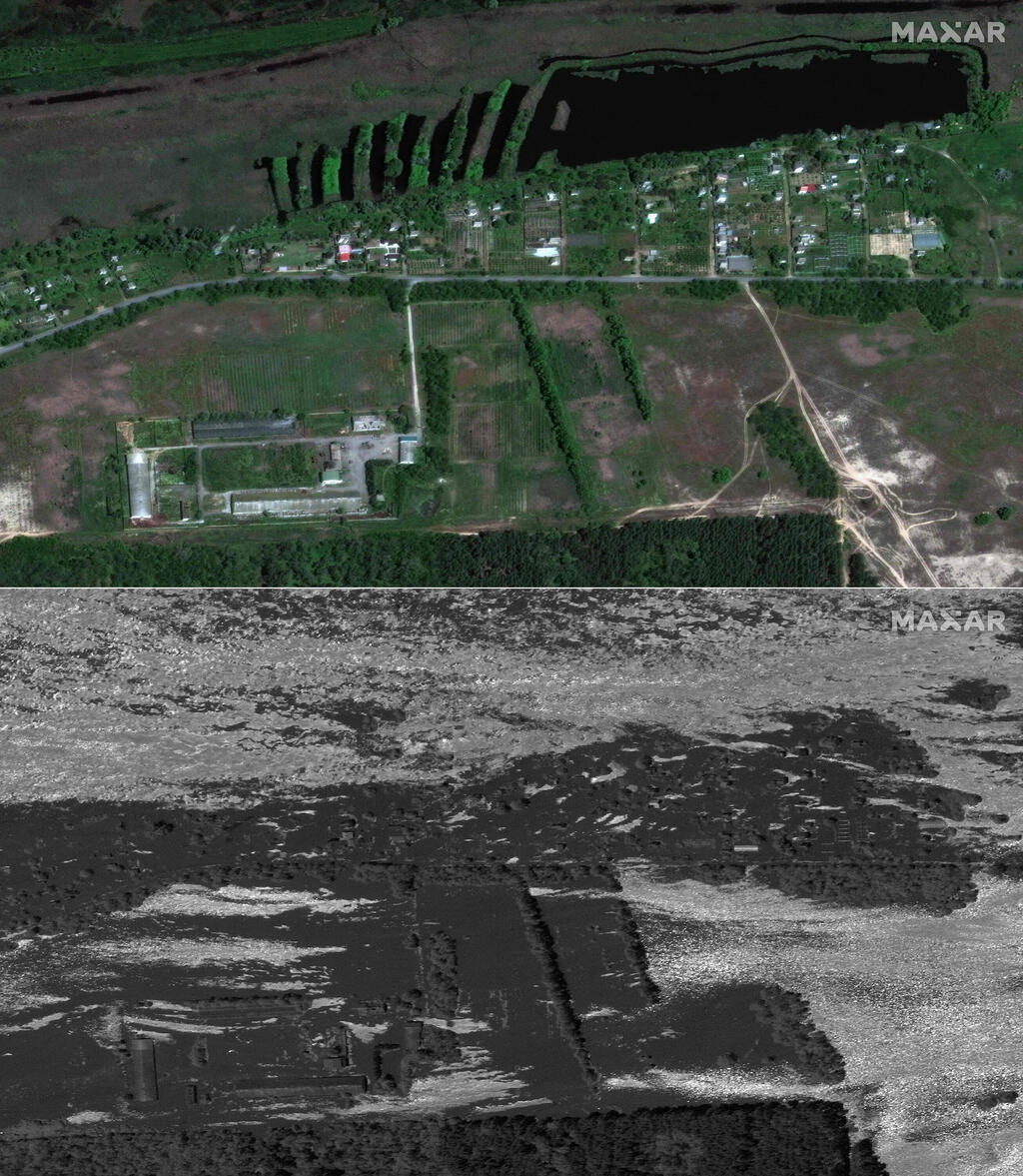

Aftermath of the Kakhova dam explosion
(Photo: AFP PHOTO / Satellite image ©2023 Maxar Technologies)
Alongside the ongoing humanitarian disaster in Ukraine, there are warnings about the severe and long-term environmental consequences of the massive floods. At least 150 tons of machine oil leaked as a result of the destruction at the dam, and experts warn that other hazardous substances may be washed away, heavily polluting extensive agricultural and fertile areas, thus affecting crop cultivation for an extended period. Another concern is that it will take years to clean up the mud that will remain once the water recedes. Ukraine is one of the world's major wheat and grain exporters, and evidence of the anticipated damage was seen on Tuesday with a 3% spike in wheat prices.
The flooding in the region also severely affects the local wildlife, which includes several rare species. The pro-Russian government controlling parts of the region reported Wednesday morning that thousands of animals were killed in one of the national parks that flooded. Andriy Yermak, head of the Office of the President of Ukraine, shared a video on Wednesday morning showing numerous fish, which, according to him, were swept into the flooded areas and carried away by the rapid waters. He, too, accused Russia of an "ecocide," indicating a deliberate and severe impact on the environment.
President Zelensky himself, in his late-night address to the nation, said that the explosion at the dam was within the scope of "activating an environmental destruction mass bomb." This morning, Zelensky warned that the disaster could also affect the access of hundreds of thousands of people to drinking water. Additionally, Russian media outlets reported this morning that minefields, which were laid by Russian forces, were also flooded, raising concerns that the mines were washed away by the current.
The explosion at the dam also brought attention to the Zaporizhia nuclear power plant, which is also under Russian control and receives its necessary water supply for cooling the nuclear reactors from the Kakhovka reservoir. Last year, the power plant was repeatedly targeted by bombings, and there were concerns in the world about a nuclear disaster similar to the one that occurred in Chernobyl. Those concerns have not materialized, and on Tuesday the International Atomic Energy Agency (IAEA) clarified that there is currently no immediate danger to the plant. Five out of six reactors there are already shut down, and according to the agency, alternative water sources could be used if necessary for several months.
Meanwhile, despite the disaster in the region, the Ukrainian army reported progress on the eastern front in the Donetsk region. According to their statement, Ukrainian forces succeeded in advancing between 200 and 1,000 meters in several areas around the devastated city of Bakhmut, which saw the most intense and prolonged battle in the war. Last month, Russia claimed to have completed the occupation in Bakhmut, but Kyiv insisted on maintaining control over the surrounding territories and now claims that it has made significant advances there.
"Our forces have shifted from defense to offense in the direction of Bakhmut," declared Deputy Minister of Defense of Ukraine Hanna Maliar. Russia itself has claimed in recent days that it is repelling "large-scale attacks" by the Ukrainian army in the area. Kyiv continues to maintain ambiguity and does not explain whether it is the same long-anticipated major counteroffensive attack.
First published: 16:01, 06.07.23




